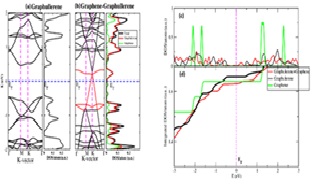Graphene-Graphullerene Heterostructure: A Novel Material for High-Performance Capacitors
DOI:
https://doi.org/10.61343/jcm.v3i01.76Keywords:
DFT, Graphullerene, Electronic band structureAbstract
This study introduces a novel graphene-graphullerene heterostructure as a promising material for high-performance capacitors. Compared to pristine graphene, this heterostructure exhibits a significantly larger surface area and porosity which enhance its energy storage capacity. Pristine graphullerene is a semiconductor with a bandgap of 0.92 eV and its integration with graphene effectively modifies its electronic properties, rendering it conductive as confirmed by band structure analysis. The unique combination of graphene's high conductivity and graphullerene's extended surface area and porosity presents a promising avenue for developing capacitors with exceptional performance characteristics.
References
A. Geim and K Novoselov, Nature Mater, 6,183 (2007).
M. A. Khan, M. Atif, M. N. Leuenberger. arXIV 2404.16743. (2024).
L. Guang-Ye, M. Shi-Cong, Q. Xin-Yue, N. Jing, L. Jun-Xi, L. Pei-Yi, N. Feng, C. Shi-Zhang, ACS Applied Nano Materials 8(1), 649 (2024).
U. Argaman and G. Makov, npj Comp. Mat. 9, 211 (2023).
C. Liu, X. Yan, F. Hu, G. Gao, G. Wu, and X. Yang, Adv. Mater 30, e1705713 (2017).
J. M. Soler, E. Artacho, J. D. Gale, A. Garcia, J. Junquera, P. Ordejon and D. S. Portal, J. Phys.: Condes. Matter, 14 2745 (2002).
J. P. Perdew, K. Burke and M. Ernzerhof, Phys. Rev. Lett, 77:3865 (1996).
K. Chaudhary and F. Tavazza Comp. Mater. Sc. 161, 300 (2019).
A. Z. Zahran and G. P. Srivastava, App. Surf. Sc. 256 (19), 5783 (2010)
A. Devi, A. Kumar, A. Singh and P. K. Ahluwalia, AIP Conf. Proc. 2115, 030386 (2019).
S. E. Veras, E. Espada and G. Morell, Carbon Trends 15, 100360 (2024).
A. Devi, A. Kumar, P. K. Ahluwalia A. Singh, Materials Science and Engineering: B 271, 115237 (2021).

Downloads
Published
How to Cite
Issue
Section
Categories
License
Copyright (c) 2025 Dr. Anjna Devi, Satish Kumar, Arun Kumar

This work is licensed under a Creative Commons Attribution 4.0 International License.
Copyright© by the author(s). Published by journal of Condensed Matter. This is an open access article distributed under the terms of the Creative Commons Attribution (CC BY) license (https://creativecommons.org/licenses/by/4.0/), which permits unrestricted use, distribution, and reproduction in any medium, provided the original author(s) and source are credited.









